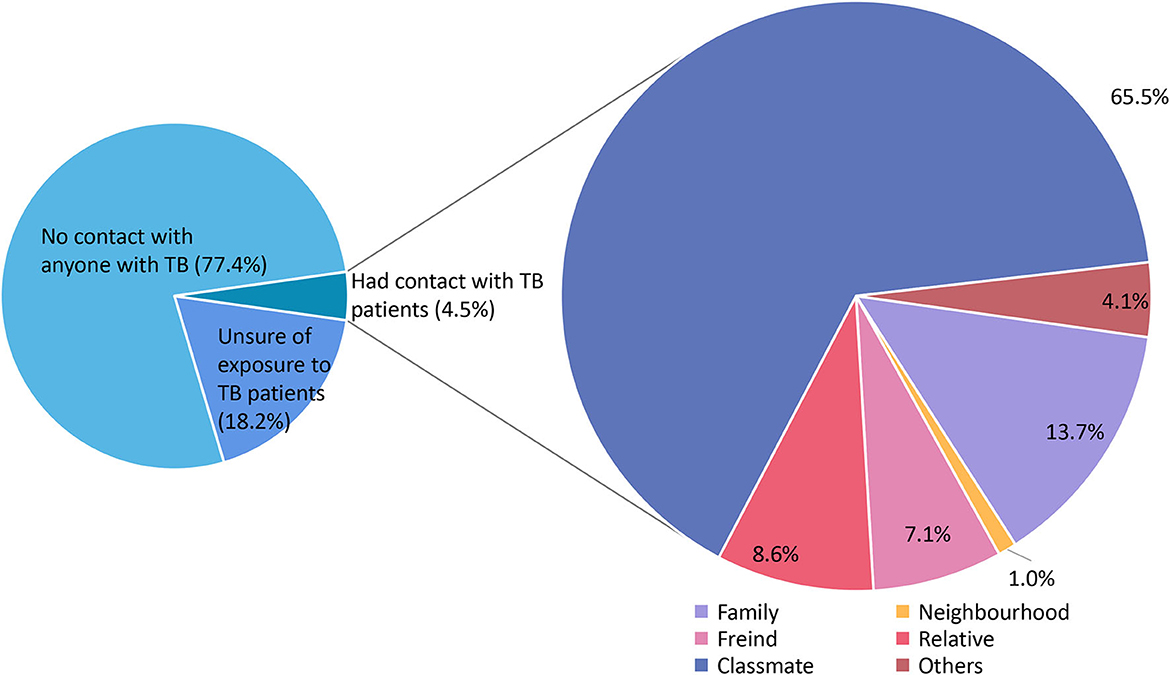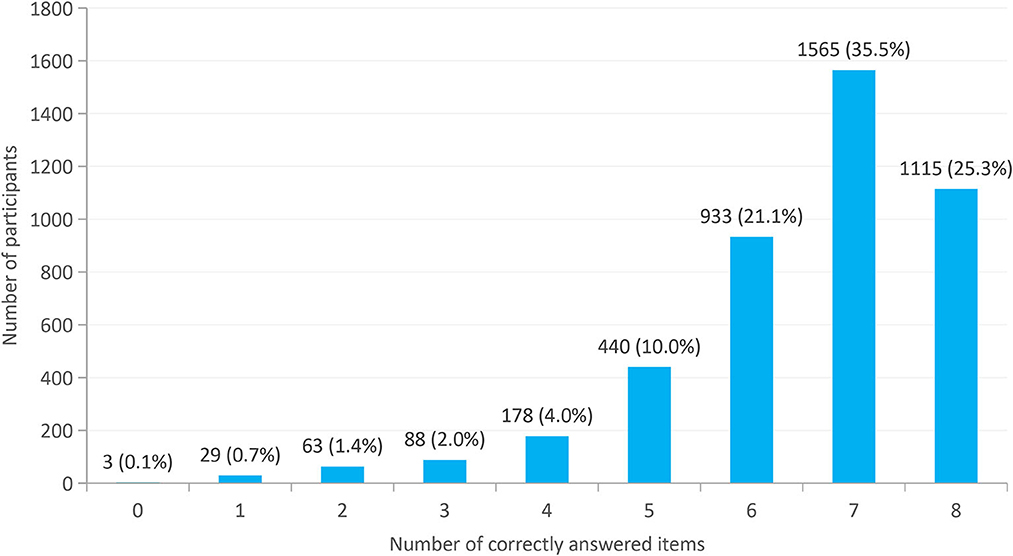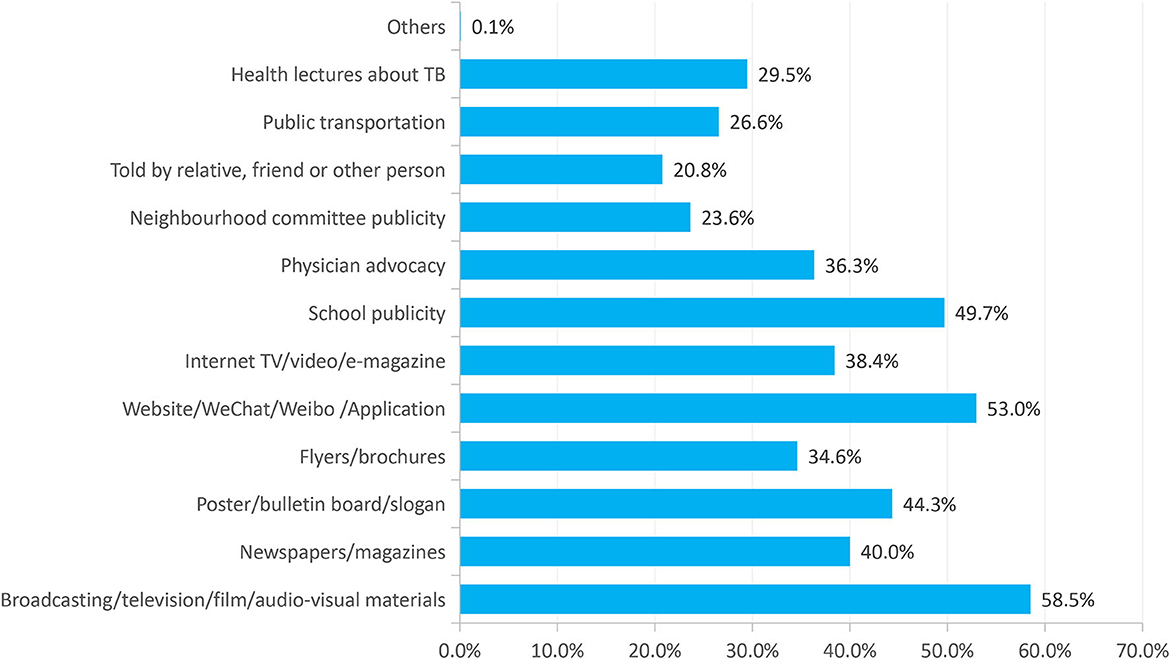- 1Department of Tuberculosis Control and Prevention, Zhejiang Provincial Centre for Disease Control and Prevention, Hangzhou, China
- 2National Centre for Tuberculosis Control and Prevention, Chinese Center for Disease Control and Prevention, Beijing, China
Background: College students, especially those in the lower grades, constitute the main high-risk population for tuberculosis (TB). Insufficient knowledge about TB among college students contributes to an increased risk of TB infection. In Zhejiang Province, China, limited research has been conducted recently on the awareness of TB in schools among college students. Therefore, this study aims to gain insight into TB knowledge among low-grade college students in Zhejiang Province and develop effective strategies for TB education targeted at this specific population.
Methods: A cross-sectional survey was conducted between 1st and 20th May 2022 in 20 colleges in Zhejiang Province, southeastern China. The survey aimed to assess the level of TB awareness among 1st and 2nd-year college students. Chi-square tests were performed to compare the rates, while multivariate logistic regression was used to identify the factors influencing the overall awareness level of students' regarding key knowledge about TB.
Results: A total of 4,414 lower-grade students participated in the study. The total awareness rate and entire awareness rate of key TB knowledge were 81.6 and 25.3%, respectively. Participants who demonstrated a relatively poor understanding of the definition were (51.0%), curable outcomes (75.7%), and preventive measures of TB (76.1%). Female participants [adjusted odds ratio (aOR):1.44; 95% confidence interval (CI):1.25–1.65], medical students (aOR:2.00; 95%CI:1.63–2.64), had a high level of monthly expenditures (aOR:2.50; 95%CI:1.49–4.19), had prior TB health education (aOR:1.95; 95%CI:1.68–2.25) and previous exposure to TB patients (aOR:2.13; 95% CI:1.48–3.08) indicating a better level of awareness of key knowledge about TB. Among the students, 58.5% expressed their willingness to acquire TB knowledge through “broadcasting, television, films, and audiovisual materials.”
Conclusions: The total awareness rate of key knowledge among low-grade college students in Zhejiang did not meet the national requirements. To effectively prevent TB in schools, it is crucial to develop a comprehensive understanding of the disease among college students. Therefore, it is necessary to enhance TB awareness through theoretical and practical education, starting from the early semesters of college.
1. Introduction
Tuberculosis (TB), an ancient disease caused by Mycobacterium tuberculosis (MTB), maintains its daunting position as the 13th leading cause of death worldwide and the leading cause of death from a single infectious agent since 2019 (1). Among the 22 high-burden countries, China ranks third and faces challenges in protecting high-risk, vulnerable, and special populations from TB (1). In 2018, nationwide TB cases reported among students reached 48,289, with an incidence rate of 17.97/100,000, representing a 29.19% increase compared to 2014 (13.91/100,000) (2). In many provinces of China, the number of students with TB ranks second, just behind farmers and herdsmen (3).
In recent years, the number of college students in China has been increasing due to the dramatic expansion of college enrolment (4). Hence, TB prevention and control among colleges have become increasingly important (5). Previous studies have identified college and university students aged 19–22 years as the main population at high-risk for TB (6). Factors such as high population density, close contact, and increased mobility contribute to TB infection and transmission among college students. Additionally, a lack of awareness about TB is considered an essential factor that increases the risk of exposure to the disease (7). However, a previous survey indicated inadequate knowledge of TB among students (8). Several studies have shown that even when many 1st-year students exhibited suspicious symptoms of TB, such as coughing and sputum for more than 2 weeks (9–11), both patients themselves and their fellow classmates lacked awareness of TB. This led to delays in seeking medical care and reporting to the school medical staff, resulting in a high prevalence of TB in the colleges (12).
Zhejiang Province in southeastern China serves as a representative province, which is composed of 11 prefectures and 90 county-level administrative regions. It is one of the most densely populated provinces in China, with the fourth highest gross domestic product (GDP) and a continuously growing migrant population. According to the report of the fourth provincial TB key awareness investigation, the total awareness rate of the public in Zhejiang Province was 48.0%, of which only 38.0% was among students, the lowest among all walks of life (13). In 2021, the Tuberculosis Information Management System (TBIMS) reported more than 30 school-related TB outbreaks in the province, with approximately one-third of these outbreaks occurring in colleges. College students come from diverse regions across the country, and their living environments and study patterns have changed significantly compared to those of high school students. In particular, junior students who have recently entered college may struggle to adapt to a new environment and may become prone to TB once their resistance decreases. A study showed that the prevalence rates of active TB among college students in China ranged from 0.40 to 1.52%, with outbreak rates as high as 2.89–4.20%, significantly higher than the rate in the general population (14). Currently, TB prevention in colleges mainly relies on TB health education, which is widely considered an effective approach to promote TB knowledge among students. College students, being a population with a high incidence of TB possess a higher level of knowledge and acceptance and a stronger sense of social responsibility. Therefore, health education on TB is easily implementable and accepted among them, yielding efficient results in the prevention of TB. However, there have been limited studies specifically investigating the level of TB awareness among low-grade college students in recent years. This lack of research impedes the scientific evaluation of the effectiveness of current TB education methods. Hence, this study targeted low-grade college students to assess their level of TB awareness and explore the sociodemographic determinants associated with their perception of this infectious disease. The findings of this study will provide a basis for optimizing TB prevention and control strategies in colleges and universities.
2. Materials and methods
2.1. Study setting
A cross-sectional survey was conducted between 1st and 20th May 2022 in 20 colleges in Zhejiang Province, southeastern China, and focused on the assessment of key TB knowledge among low-grade college students. As of 2022, Zhejiang Province was home to 109 institutions of higher education, mainly distributed in the southern and northern regions, ranking eleventh among all Chinese provinces.
2.2. Participants
A cluster random sampling strategy was used for participants selection. Specifically, 20 colleges were randomly selected from four cities within the north and south of the Zhejiang Province: Hangzhou (eight), Ningbo (five), Wenzhou (five), and Jiaxing (two). Approximately 8 to 10 freshman and sophomore classes were randomly selected from the selected samples, and 20 to 25 male and female students in these classes were randomly selected for the study. Totally 4,414 subjects were investigated in this study.
2.3. Questionnaire and quality control
In this study, a unified electronic questionnaire was adopted to collect information, which was formulated based on the Technical specifications for tuberculosis prevention and control in China (2020 Edition) (15) and the School TB Prevention and Control Work Specification (2017 Edition) (16), as well as literature and expert consultations, including three aspects: participants' sociodemographic characteristics, knowledge of key information regarding TB occurrence in schools, and accessibility to TB knowledge. The key knowledge of TB included eight items (see Supplementary Table S1) with several options for TB key knowledge, which contained only one correct answer for each item.
The local Centre for Disease Control and Prevention (CDC) staff at each investigated school were responsible for the interviews and collection of the questionnaires. These investigators received provincial training and followed unified investigation guidelines to ensure authenticity and integrity of the entire process. The provincial CDC routinely verified the responses provided in the electronic questionnaire daily, including checking the number, completeness, and logical coherence of the responses, facilitating the identification and timely rectification of any errors. The final questionnaire database was uniformly established at the provincial level, and quality verification was performed.
2.4. Definition of items
In this study, low-grade students included 1st- and 2nd-year undergraduate students at these 20 colleges. The total awareness rate of the eight key TB information items was calculated by dividing the number of correct answers provided by all participants by the total number of answers to the eight questions. The entire awareness rate represents the percentage of participants who correctly answered all key TB knowledge questions out of the total number of survey participants. The awareness rate of each key TB knowledge item was calculated as the percentage of participants who correctly answered the questions for that item out of the total number of participants who answered it. The average of the correct answers given by all participants was used to divide the awareness level, with scores higher than the average indicating good awareness and scores lower than the average indicating poor awareness.
2.5. Statistic analysis
The survey data were collated using Microsoft Excel and exported to SPSS package, v24.0.0 (IBM Corporation, Armonk, NY, USA), for analysis. Descriptive data were summarized and presented as frequencies and percentages. A chi-square test was performed to assess the awareness levels of participants with different characteristics. Covariates with p-values < 0.10 in the univariable analysis were considered for inclusion in the multivariable logistic regression model. Adjusted odds ratios (aOR) and 95% confidence intervals (CI) were presented to show the association between participant characteristics and their awareness level of TB. A p-value ≤ 0.05 was considered statistically significant.
3. Results
3.1. Demographic characteristics of participants
As presented in Table 1, a total of 4,414 questionnaires were collected. The majority of participants were 20 years old (42.8%). The proportion of females was slightly higher than that of males (51.7 vs. 48.3%, respectively). The Han ethnic group constituted the vast majority of the population (96.1%). Nearly 64.6% of participants resided in rural areas. Approximately 71.5% of the participants attended high school in Zhejiang Province. Among all the low-grade college students, freshmen accounted for 53.9%. Science and engineering professions had the highest group of participants (45.1%), followed by humanities and social sciences (31.0%). The majority of participants' parents were junior high school graduates, accounting for 40.0%. Nearly 70.3% of the participants had a monthly spending range between 1,000 and 2,000 RMB. A total of 77.1% of participants indicated that they had received previous knowledge about TB. Only 0.6% of the participants had suffered from TB, and 4.5% had previous exposure to patients with TB, while the 77.4% of the participants had not been exposed to patients with TB, and 18.2% responded that they did not know. Figure 1 further demonstrated the relationship between participants who responded that they had been exposed to a TB patient and the patient. Among 197 participants who had been exposed to TB patients, approximately 65.5% of the TB patients were their classmates, followed by family members (13.7%).
3.2. Awareness of TB key knowledge
Overall, the participants' total awareness rate for the eight key knowledge items in the survey was 81.6% (Figure 2). For each of the key knowledge, the participants' awareness level of TB as a chronic infectious disease was the lowest (Q1), at 51.0%, followed by the curability of TB with a correct response of 75.7% (Q5). However, the participants demonstrated good knowledge of the TB transmission modes (Q2, 90.0%), suspicious symptoms (Q3, 91.1%), and where to seek medical help after suspected TB (Q4, 96.2%), with awareness rates for all three types of information exceeding 90.0%. The awareness of each key knowledge of TB among the different characteristics of the participants is shown in Supplementary Table S2.
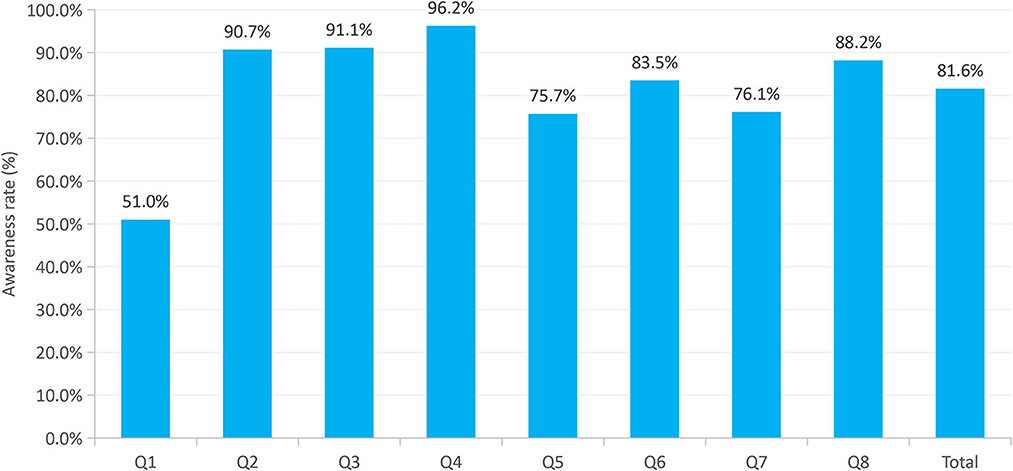
Figure 2. Participants' awareness rate of each TB key knowledge among low-grade college students in Zhejiang Province, southeastern China. Q1: what is TB; Q2: how is TB transmitted; Q3: what are the suspicious symptoms of TB; Q4: if you suspect that you have TB, what should you do; Q5: is TB curable; Q6: while at school, when you develop suspicious symptoms of TB or are diagnosed with TB, what should you do; Q7: what practice is beneficial in preventing the spread of TB; Q8: which lifestyle habit will improve your immunity?
Table 2 presents the details of the responses regarding key TB knowledge. In this study, approximately half of the participants (51.0%) were aware that TB is a chronic communicable disease, while 31.5% recognized it as a communicable disease. The majority (90.7%) correctly stated that TB is transmitted through the respiratory tract. Approximately 91.1 and 96.2% of participants correctly knew the suspected symptoms of TB and where to seek medical help, respectively. Regarding curability of TB, 13.8% of participants responded that they did not know, while 4.3% believed it was not curable. When asked about students being diagnosed with TB at school, 14.9% believed immediate hospitalization was necessary, and 83.5% of the participants agreed that they should be proactive in reporting their illness to school rather than hiding it or bringing it to class. Most participants (76.1%) mentioned appropriate methods for preventing TB transmission. However, about 3.2% of participants described inappropriate lifestyle habits, including staying up late, overeating, occasional exercise, and irregular exercise or diet.

Table 2. Responses to eight TB key knowledge among low-grade college students in Zhejiang Province, southeastern China.
The average of correct answers given by all participants was approximately 6.5. Therefore, participants who correctly answered seven and eight key knowledge items were classified as having good awareness, and participants who correctly answered less than or equal to six key knowledge items were classified as having poor awareness. As shown in Figure 3, the total number of students who correctly answered more than six messages was 2,680 (accounting for 60.7%). Three participants (0.1%) incorrectly answered all eight core messages, and the entire awareness rate was only 25.3%.
3.3. Factors associated with the level of awareness
As presented in Table 3, the level of awareness regarding key TB knowledge among lower-grade college students varied by sex (p < 0.001), place of residence (p = 0.013), discipline of study (p < 0.001), monthly living expenses (p < 0.001), prior knowledge about TB (p < 0.001), and exposure to TB patients (p < 0.001). A greater proportion of females (65.5%) had higher awareness levels than males (56.3%). Approximately 63.2% of participants residing in urban areas had a good level of awareness. Among different disciplines, students in the field of medicine had the highest proportion with good awareness of TB, accounting for 73.3%. The proportion of participants with better awareness of TB tended to increase with higher monthly living expenses. Students who had received prior TB education (64.4%) and those who had been in contact with TB patients (76.6%) had a higher percentage of good awareness level.
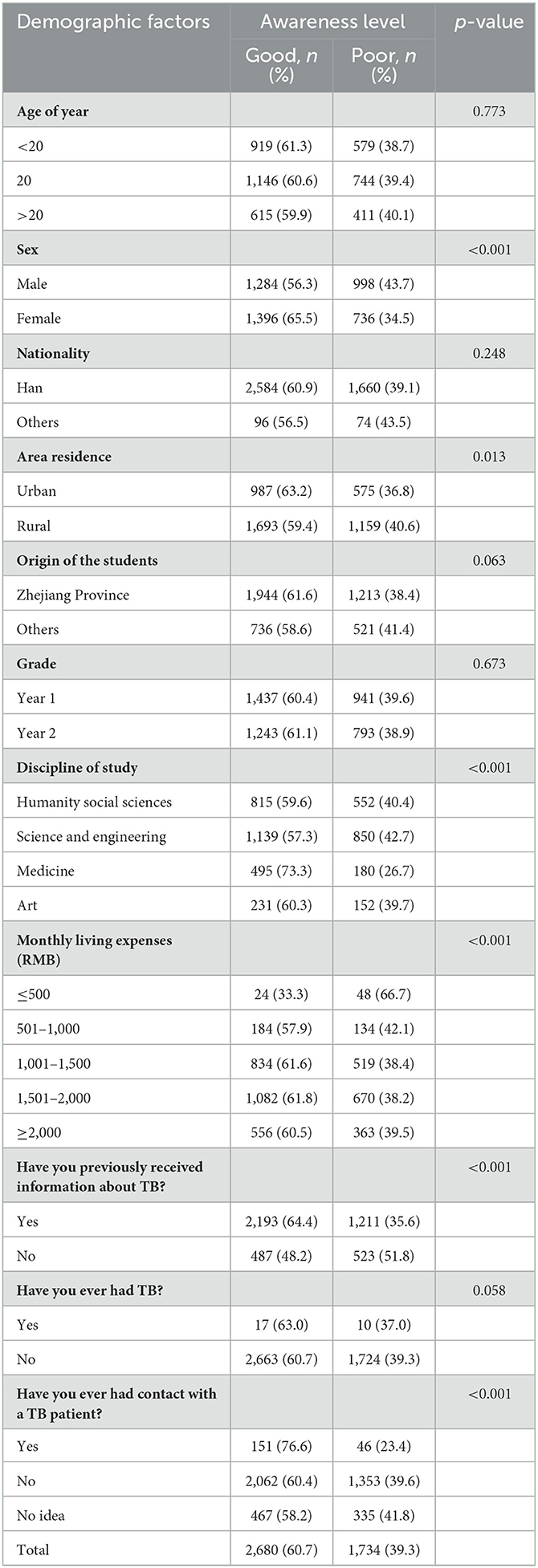
Table 3. Comparison of the awareness level of TB among low-grade college students with different characteristics in Zhejiang Province, southeastern China.
Table 4 demonstrates the results of multivariate logistic regression model, indicating that females were more likely to have a better awareness of key TB knowledge compared to males (aOR: 1.44; 95%CI: 1.25–1.65). Medical students exhibited significantly higher levels of TB awareness compared to students in humanities and social sciences (aOR: 2.00; 95%CI: 1.63–2.64). Additionally, students with higher living costs were more knowledgeable than those with lower living costs. There was also a positive association between receiving knowledge about TB and better awareness (aOR: 1.95; 95%CI: 1.68–2.25). Participants previously exposed to TB patients were approximately twice as likely to have higher levels of TB key knowledge than those who were unsure if they had been exposed (aOR: 2.13; 95%CI: 1.48–3.08).
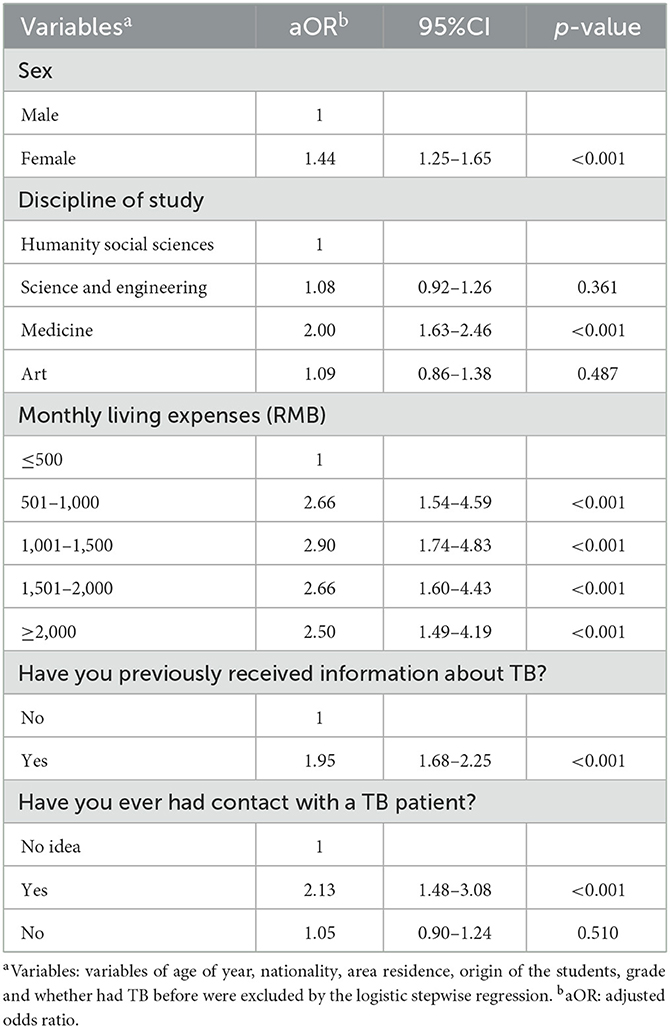
Table 4. Factors associated with the level of awareness toward TB among low-grade college students with different characteristics in Zhejiang Province, southeastern China.
3.4. The preference for the ways of TB health education
In Figure 4, regarding the ways of acquiring knowledge about TB, 58.5, 53.0, and 49.7% of the students expressed willingness to receive TB knowledge through “Broadcasting/television/film/audio-visual materials,” “Website/WeChat/Weibo/Application,” and “School publicity,” respectively.
4. Discussion
Students constitute a pivotal demographic in the prevention and control of TB, and their comprehension of this disease is indispensable in curbing its incidence among them. In this study, a deeper understanding of the actual circumstances faced by lower-grade college students regarding TB knowledge was obtained through a validated questionnaire. The overall awareness rate of key TB knowledge among low-grade college students in Zhejiang Province in 2022 was 81.6%, which was lower compared to 89.02% in Jiangsu Province (17) but higher than 73.3% in Guangxi Zhuang Autonomous Region (4). Nevertheless, a gap remains to be bridged to achieve the target (≥85%) among populations proposed by the “13th Five-Year” National TB Control Plan in China. This indicates that educational interventions are still necessary to improve TB knowledge among college students.
Assessing students' knowledge of TB based solely on total knowledge is flawed as the overall knowledge rate decreases with increasing key knowledge questions (17). Therefore, It should be evaluated in conjunction with the entire awareness rate. In our study, the overall awareness rate among all low-grade college students was only 25.3%, which was lower than the score (43.45%) reported in a previous study conducted in Hunan Province (18), but higher than the 16.03% reported in a survey conducted in Beijing (19). A survey assessing students' knowledge of four infectious diseases (Hepatitis B, Hepatitis C, AIDS, and TB) revealed a high error rate in the awareness of these diseases, except for AIDS (20), which was consistent with the results of our study.
Our survey revealed an imbalanced in the awareness levels of eight key aspects of TB knowledge among lower-grade college students, with awareness rates ranging from 51.0 to 96.2%. This indicates that the students' understanding of TB prevention and control is not comprehensive, necessitating the implementation of various forms of education to address these knowledge gaps. Specifically, students demonstrated confusion regarding the definition of TB, particularly in distinguishing whether it is an acute or a chronic infectious disease. Consequently, this key message had the lowest awareness rate among all items of TB core knowledge. Some students expressed uncertainty about the curability of TB, while others were unsure about the preventive measures against TB transmission. Despite these gaps, lower-grade students exhibited a high level of awareness about TB transmission routes, suspicious symptoms, the importance of not concealing physical conditions, seeking immediate treatment from designated medical institutions for TB consultation upon illness, and adopting an immune-enhancing lifestyle. These findings were consistent with previous research (4, 8, 21), indicating a positive trend in health-seeking behavior among our students. Notably, several studies have established an association between TB perceptions and early treatment-seeking (22, 23).
Regarding the factors influencing TB awareness level, it was found that the discipline of study was one of the crucial factors affecting the awareness level toward TB knowledge among low-grade college students. Medical students had significantly higher awareness levels than students in other disciplines, similar to the findings of surveys conducted at 15 Italian and Jordanian universities (24, 25). This may be related to the possibility that medical students are exposed to more medical knowledge and exhibit more interest in medical-related content during their study practice. However, medical students' awareness of the definition (57.2%) and curability (81.2%) of TB was relatively weak. This might be because 1st-year and 2nd-year medical students have just started to come into contact with clinical professional knowledge, and their mastery of the specialty is not yet comprehensive. However, medical students in universities or colleges can be exposed to TB infections during clinical rotations (26), and an inadequate knowledge of TB can increase their risk of infection. As potential future physicians or leaders in the fight against TB, medical students' knowledge toward TB will directly impact future efforts aimed at controlling the disease. Therefore, raising awareness of TB among medical students should be considered an important issue in medical education. Besides, in this study, lower-grade students with a higher overall awareness rate of the eight core knowledge of TB were those who had suffered TB or received TB health education before enrolment, which is consistent with similar studies findings (27–29). TB health education is a crucial strategy in China's effort to control TB, aiming to raise awareness of TB control policies and knowledge among diverse groups, enabling them to adopt appropriate behaviors and implement effective TB control strategies. By doing so, the ultimate goal of bringing the TB epidemic under control can be achieved. Although, there has been continuous focus on TB health education and promotion for the general public, particular attention has been given to TB patients and students in China (30). However, the state of TB health education and promotion in universities and colleges remains sub-optimal. This current scenario indicates the urgent need to strengthen theoretical and practical health education on TB from the beginning of university or college enrolment. Since students are accustomed to receiving education while in school, they are more receptive and responsive to targeted health education messages and are more inclined to absorb the information and disseminate TB knowledge to their families and communities through the “teacher-student-parent-community” chain (4, 31). This, in turn, has a significant impact on raising TB awareness throughout society.
College students are currently in the midst of a digital age, where mobile phones and computers have become the primary means of socializing and acquiring knowledge (32). Our study revealed that students were more likely to receive TB health education through news media and the Internet, compared to traditional promotional materials. Therefore, taking advantage of the above-mentioned means and methods of publicity can be effectively implemented. In addition, focus should be placed on the development and use of news media platforms such as the Internet, Weibo, and WeChat- to promote TB education, cultivate more student volunteers to promote TB prevention, and facilitate peer education. The rapid development of the Internet has broadened students' access to the world; however, the quality of information in the cyber world cannot be guaranteed, and students are susceptible to receiving inaccurate information. Thus, agencies involved in disease control and prevention should increase online publicity and strengthen the supervision of false disease information on the Internet to ensure students obtain accurate knowledge on disease prevention.
This study employed an innovative approach in the Internet Era by utilizing an electronic questionnaire, which provides new ideas and methods for disseminating knowledge and investigating TB prevention and control in schools. However, this study has some limitations. First, due to geographical constraints, economic conditions, and low prevalence of TB in Zhejiang Province, our findings may not fully represent TB awareness among lower-grade college students nationwide, especially in economically disadvantaged and high-prevalence areas of the disease. Second, since this study involved 20 colleges, we had to use an open online questionnaire platform and did our best to ensure that the survey reached only the target population. Nevertheless, we acknowledge the possibility of non-students receiving the survey link and completing the questionnaire. Third, as this was a cross-sectional study, we could not draw a causal relationship between the factors and their effects.
5. Conclusion
The total awareness rate of key TB knowledge among college students in Zhejiang Province fell short of national requirements, indicating a generally low level of awareness. Schools face significant and arduous tasks in TB prevention and control. To improve TB awareness among students, it is necessary to constantly innovate the content and delivery of health education and carry out comprehensive and multi-dimensional publicity activities suitable for school health education and promotion, with particular attention given to addressing the weak points in students' TB knowledge. Targeted health education on key TB knowledge should be provided, taking into account the preferences and needs of students at different levels and grades. This approach will contribute to fostering improved behavioral habits and strengthening the ability to prevent and control TB.
Data availability statement
The original contributions presented in the study are included in the article/Supplementary material, further inquiries can be directed to the corresponding authors.
Ethics statement
The studies involving human participants were reviewed and approved by Zhejiang Provincial Centre for Disease Control and Prevention. The participants provided their written informed consent to participate in this study.
Author contributions
XC: Formal analysis, Funding acquisition, Methodology, Writing—original draft, Writing—review & editing. YP: Formal analysis, Methodology, Writing—review and editing. LZ: Formal analysis, Writing—review & editing. FW: Formal analysis, Writing—review & editing. BC: Conceptualization, Funding acquisition, Project administration, Supervision, Writing—review & editing. YQ: Conceptualization, Project administration, Supervision, Writing—review & editing.
Funding
The author(s) declare financial support was received for the research, authorship, and/or publication of this article. This work was supported by the program of university volunteers' TB prevention and control advocacy in promoting patient finding, the Health Commission of Zhejiang Province [2023KY642], and the National-Zhejiang Health Commission Major S&T Project [WKJ-ZJ-2118].
Acknowledgments
We would like to thank the staffs from all the local CDCs for the collection of the questionnaires.
Conflict of interest
The authors declare that the research was conducted in the absence of any commercial or financial relationships that could be construed as a potential conflict of interest.
Publisher's note
All claims expressed in this article are solely those of the authors and do not necessarily represent those of their affiliated organizations, or those of the publisher, the editors and the reviewers. Any product that may be evaluated in this article, or claim that may be made by its manufacturer, is not guaranteed or endorsed by the publisher.
Supplementary material
The Supplementary Material for this article can be found online at: https://www.frontiersin.org/articles/10.3389/fpubh.2023.1272494/full#supplementary-material
References
1. World Health Organization. Global Tuberculosis Report 2022. Geneva: World Health Organization (2022).
2. Chen H, Xia YY, Zhang CY, Cheng J, Zhang H. Epidemic trends and characteristics of pulmonary tuberculosis in students in China from 2014 to 2018. Chin J Antitubercul. (2019) 41:662–8. doi: 10.3969/j.issn.1000-6621.2019.06.013
3. Zhang S, Ruan W, Li Y, Wang X, Wang X. Experiences of the parents caring for their children during a tuberculosis outbreak in high school: a qualitative study. BMC Public Health. (2014) 14:132. doi: 10.1186/1471-2458-14-132
4. Wu T, He H, Wei S, Pan J, Yang J, Huang S, et al. How to optimize tuberculosis health education in college under the new situation? Based on a cross-sectional study among freshmen of a medical college in Guangxi, China. Front Public Health. (2022) 10:845822. doi: 10.3389/fpubh.2022.845822
5. Wang YH, Tian Y, Gao JX, Lei CK, Liu YW, Han ZM, et al. Tuberculosis prevalence among university freshmen in Zhengzhou, China, during 2004–2013. Afr Health Sci. (2018) 18:1109–16. doi: 10.4314/ahs.v18i4.32
6. Jiang H, Zhang S, Ding Y, Li YL, Zhang TH, Liu WP, et al. Development and validation of college students' tuberculosis knowledge, attitudes and practices questionnaire (CS-TBKAPQ). BMC Public Health. (2017) 17:949. doi: 10.1186/s12889-017-4960-x
7. Getnet F, Demissie M, Assefa N, Mengistie B, Worku A. Delay in diagnosis of pulmonary tuberculosis in low-and middle-income settings: systematic review and meta-analysis. BMC Pulm Med. (2017) 17:202. doi: 10.1186/s12890-017-0551-y
8. Zhao Y, Ehiri J, Li D, Luo X, Li Y. A survey of TB knowledge among medical students in Southwest China: is the information reaching the target? BMJ Open. (2013) 3:e003454. doi: 10.1136/bmjopen-2013-003454
9. Li H, Liu C, Liang M, Liu D, Zhao B, Shi J, et al. Tuberculosis outbreak in an educational institution in Henan Province, China. Front Public Health. (2021) 9:737488. doi: 10.3389/fpubh.2021.737488
10. Fang Y, Zhang L, Tu C, Ye D, Fontaine R, Ma H, et al. Outbreak of pulmonary tuberculosis in a Chinese high school, 2009–2010. J Epidemiol. (2013) 23:307–12. doi: 10.2188/jea.JE20120216
11. Chen W, Xia Y, Li X, Zhou L, Li C, Wan K, et al. A tuberculosis outbreak among senior high school students in China in 2011. J Int Med Res. (2012) 40:1830–9. doi: 10.1177/030006051204000521
12. Rana M, Sayem A, Karim R, Islam N, Islam R, Zaman TK, et al. Assessment of knowledge regarding tuberculosis among non-medical university students in Bangladesh: a cross-sectional study. BMC Public Health. (2015) 15:716. doi: 10.1186/s12889-015-2071-0
13. Chen XY, Wang W, Wang X, Chai CL, Liu K, Peng Y, et al. Public awareness of tuberculosis in southeast China: a population-based study. Int J Environ Res Public Health. (2019) 16:4290. doi: 10.3390/ijerph16214290
14. Zhang FB, Yuan FY Li SJ. Evaluation on effect of health education on key message on tuberculosis prevention and treatment. Health Med Res Prac. (2012) 9:56–8.
15. Chinese Center for Disease Control and Prevention. Technical specifications for tuberculosis prevention and control in China (2020 Edition). Beijing: People's Medical Publishing House. (2020).
16. National Health Commission of the People's Republic of China. School TB Prevention and Control Work Specification (2017 Edition). E. coli. (2017). http://www.moe.gov.cn/srcsite/A17/moe_943/s3285/201707/t20170727_310182.html (accessed October 16, 2023).
17. Du G, Li C, Liu Y, Tu F, Yang R, Li R, et al. Study on the influencing factors of knowledge, attitudes and practice about tuberculosis among freshmen in Jiangsu, China: a cross-sectional study. Infect Drug Resist. (2022) 15:1235–45. doi: 10.2147/IDR.S351541
18. Feng SD, Yang SQ, Ling HY. Investigation on knowledge, attitude and behavior regarding tuberculosis in university students in Hengyan City. Chin J Sch Doct. (2011) 25:815–7.
19. Ma QH, Shang XY Ji XY, Guo Y, Xie N, Jin AN, et al. Investigation on the core knowledge of tuberculosis prevention and control among students in two middle school in Beijing. Chin J Antituberc. (2022) 44:1213–7. doi: 10.19982/j.issn.1000-6621.20220320
20. Song L, Li SL. Investigation and analysis of 2746 high school students' cognition of four common infectious diseases. Chin Youjiang Med J. (2020) 48:769–74. doi: 10.3969/j.issn.1003-1383.2020.10.009
21. Zhang XM, Yu YM, Pang XW, Wan Y, Jia JW, Xu R, et al. Investigation and analysis of tuberculosis awareness among students in 9 schools in Tianjin City in 2021. J Tuberc Lung Dis. (2022) 3:483–9. doi: 10.19983/j.issn.2096-8493.20220153
22. Zhang T, Liu X, Bromley H, Tang S. Perceptions of tuberculosis and health seeking behaviour in rural Inner Mongolia, China. Health Policy. (2007) 81:155–65. doi: 10.1016/j.healthpol.2005.12.009
23. Li Y, Ehiri J, Tang S, Li D, Bian Y, Lin H, et al. Factors associated with patient, and diagnostic delays in Chinese TB patients: a systematic review and meta-analysis. BMC Med. (2013) 11:156. doi: 10.1186/1741-7015-11-156
24. Montagna MT, Napoli C, Tafuri S, Agodi A, Auxilia F, Casini B, et al. Knowledge about tuberculosis among undergraduate health care students in 15 Italian universities: a cross-sectional study. BMC Public Health. (2014) 14:970. doi: 10.1186/1471-2458-14-970
25. Abu-Humaidan AHA, Tarazi A, Hamadneh Y, Al-Leimon A, Al-Leimon O, Aljahalin M, et al. Knowledge, attitudes, and practices toward tuberculosis among Jordanian university students. Front Public Health. (2022) 10:1055037. doi: 10.3389/fpubh.2022.1055037
26. Silva VM, Cunha AJ, Kritski AL. Tuberculin skin test conversion among medical students at a teaching hospital in Rio de Janeiro, Brazil. Infect Control Hosp Epidemiol. (2002) 23:591–4. doi: 10.1086/501976
27. Vanaja K, Banu R, Reddy L, Kumar PC, Srinivas C, Rajani T, et al. A study on knowledge and awareness about tuberculosis in senior school children in Bangalore, India. Indian J Tuberc. (2016) 63:192–8. doi: 10.1016/j.ijtb.2015.07.001
28. Jackson M, Harrity S, Hoffman H, Catanzaro A. A survey of health professions students for knowledge, attitudes, and confidence about tuberculosis, 2005. BMC Public Health. (2007) 7:219. doi: 10.1186/1471-2458-7-219
29. Gothankar JS. Tuberculosis awareness program and associated changes in knowledge levels of school students. Int J Prev Med. (2013) 4:153–7.
30. Chineses Center for Disease Control and Prevention. The Operational Guideline for Tuberculosis Control Program in China. Beijing: Ministry of Health (2008).
31. Tian H, Wang DJ. Effects of the health education of tuberculosis prevention and control among college students based on Wechat group. Chin J Sch Health. (2017) 38:680–2. doi: 10.16835/j.cnki.1000-9817.2017.05.012
32. Burcin MM, Armstrong SN, Early JO, Godwin H. Optimizing college health promotion in the digital age: Comparing perceived wellbeing, and health behaviors, health education needs and preferences between college students enrolled in fully online versus campus-based programs. Health Promot Perspect. (2019) 9:270–8. doi: 10.15171/hpp.2019.37
Keywords: tuberculosis, awareness rate, health promotion and education, lower-grade students, questionnaire survey
Citation: Chen X, Peng Y, Zhou L, Wang F, Chen B and Qu Y (2023) The necessity for enhancing awareness of tuberculosis starting from the early college semesters: empirical evidence from a cross-sectional research. Front. Public Health 11:1272494. doi: 10.3389/fpubh.2023.1272494
Received: 04 August 2023; Accepted: 10 October 2023;
Published: 26 October 2023.
Edited by:
Adwoa Asante-Poku, University of Ghana, GhanaReviewed by:
Ephrem Tora, Arba Minch University, EthiopiaMihaela-Simona Subtirelu, University of Medicine and Pharmacy of Craiova, Romania
Copyright © 2023 Chen, Peng, Zhou, Wang, Chen and Qu. This is an open-access article distributed under the terms of the Creative Commons Attribution License (CC BY). The use, distribution or reproduction in other forums is permitted, provided the original author(s) and the copyright owner(s) are credited and that the original publication in this journal is cited, in accordance with accepted academic practice. No use, distribution or reproduction is permitted which does not comply with these terms.
*Correspondence: Bin Chen, YmNoZW5AY2RjLnpqLmNu; Yan Qu, cXV5YW5AY2hpbmFjZGMuY24=
 Xinyi Chen
Xinyi Chen Ying Peng
Ying Peng Lin Zhou
Lin Zhou Fei Wang1
Fei Wang1 Bin Chen
Bin Chen
